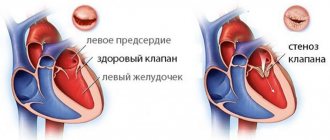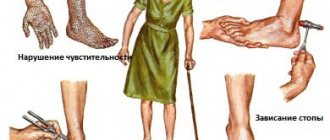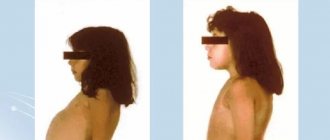Author:
- Elena Vitalievna Naumova, otolaryngologist, leading doctor of the clinic
5.00 (Votes: 2)
Hyposmia is a decrease in the sense of smell (the ability to detect odors through the nose). ICD code for hyposmia R43.
The sense of smell is one of the main senses, which plays an important role in human life. Its loss can cause depression, not to mention the fact that in this state you can miss potentially dangerous odors such as smoke, gas, spoiled food. Hyposmia may also indicate a more serious condition.
If there is a persistent decrease in the sense of smell, including with unilateral hyposmia, you should definitely seek medical help.
Causes of hyposmia
Hyposmia is often a symptom of acute sinusitis—the infection causes swelling that blocks odor particles from reaching the upper part of the nasal cavity, where the olfactory nerve is located. In this case, it goes away along with the disease and does not require special treatment. The situation is more serious when hyposmia occurs unrelated to an upper respiratory tract infection. In all other respects the person feels good.
Causes of hyposmia not associated with a runny nose:
- nasal polyps;
- deviated nasal septum;
- swelling of the tissues of the nasal cavity;
- tumors of the nasal cavity;
- nasal trauma (loss of smell due to either blockage or damage to the olfactory nerve);
- head injury;
- viral infection (this includes hyposmia after coronavirus);
- age-related changes (decreased sense of smell may be part of normal aging);
- hormonal imbalance;
- long-term exposure to certain chemicals (tobacco smoking, drug use, radiation therapy to the head and neck);
- certain medications (antibiotics, antidepressants, antihistamines);
- neurological conditions: Parkinson's disease, multiple sclerosis, Alzheimer's disease. If your sense of smell has deteriorated along with memory loss, difficulty walking, tremors, or problems with speech, you should immediately tell your doctor about these symptoms.
According to statistics, up to 22% of cases of hyposmia have no clear cause.
Tinnitus and dysosmia: two problems - one solution
As clinical practice shows, the inclusion of the drug Bronchobos® in the standard antibiotic therapy regimen increases its effectiveness. In addition, the drug Bronchobos®, used in a complex of therapeutic measures for dysosmia and rhinosinusitis, promotes rapid regression of olfactory disorders.
Results of treatment of 23 patients with tinnitus and tubular dysfunction
Tinnitus
Tinnitus (from Latin tinnitus
- ringing - subjective tinnitus) can appear and disappear or be constant, reminiscent of the roar of a turbine (low-frequency sound) or the squeak of a mosquito (high-frequency). Tinnitus can be one- or two-sided, barely noticeable in silence or intrusive. Despite the variety of characteristics, we are talking about one problem for millions of patients, doctors, neurophysiologists, and other specialists.
Tinnitus is constantly reported by about 8% of the adult population of the world [1–5]. It is believed that ear noise is not an independent disease, but a symptom of various pathological conditions, the identification of which should be the main goal of the examination.
Otiatric causes of tinnitus are associated with the formation of cerumen plug, exostosis of the external auditory canal, otitis externa, acute and chronic otitis media, tubular dysfunction, otosclerosis, tumor of the tympanic cavity, labyrinthitis, sensorineural hearing loss, barotrauma, Meniere's disease, and tumor of the cerebellopontine angle. and internal auditory canal.
Noise with retrocochlear lesions (acoustic neuroma, cerebral disorders, etc.) is characterized by monotony and a frequency of 4000–6000 Hz. When the lesion is at the cochlear level (Meniere's disease, cochlear form of otosclerosis, etc.), the noise is complex; against the background of high-frequency noise of 2000–4000 Hz, low-frequency noise of 350–600 Hz is noted [6]. With tubular dysfunction, tinnitus varies. A noise “blowing” in time with breathing is noted when the auditory tube is gaping. The noise from the “unsticking” of the pipe walls resembles the crackling and bursting of bubbles; it can be pulsating and accompanied by ear congestion of varying degrees of severity.
Subjective tinnitus can be assessed using otoacoustic emission, impedansometry in the mode of decay of the acoustic reflex with a known low stimulus, psychoacoustic noise metry (an audiometer helps to assess the height and loudness (intensity) of noise). In some cases, it is not possible to identify tinnitus, since it is quite difficult to select an acoustic signal that corresponds to the patient’s ideas about noise [7]. Currently, tinnitus questionnaires (Tinnitus Questionnaire, Tinnitus Handicap Inventory, Tinnitus Reaction Questionnaire) are used to objectively assess the severity of subjective ear noise [8–10]. Test results are assessed based on the total points scored. Visual Analog Scales can accurately assess the condition of patients with tinnitus [11]. However, it is advisable to begin the examination of such patients with otoscopy, assessing the mobility of the eardrum. Tone threshold and suprathreshold audiometry and ETF test are mandatory.
The degree of patency of the auditory tubes can be determined using:
- tests with simple swallowing - when swallowing saliva, the patient feels a “crackling” in the ears;
- Toynbee test (swallowing with the wings of the nose pressed). The patient pinches his nose and makes swallowing movements. With good patency of the auditory tubes, a “crackling” sound is also felt in the ears;
- Valsalva maneuver (straining with the nose pinched);
- blowing according to Politzer;
- catheterization of the auditory tubes.
When tubular dysfunction is detected, it is advisable to conduct an endoscopic examination of the pharyngeal opening of the auditory tube.
Bronchobos® in the treatment regimen for patients with tinnitus
From January 2015 to September 2021, 56 patients (33 women and 23 men) aged from 17 to 69 years applied to the Scientific and Clinical Center of Otorhinolaryngology of the Federal Medical and Biological Agency of Russia with complaints of tinnitus. The duration of the disease varied from a month to several years (five patients could not accurately indicate the onset of the disease).
14 (25.0%) patients had not received previous treatment, in 36 (64.3%) the therapy was ineffective, six (10.7%) noted positive dynamics from the treatment, but did not consider it sufficient. In our opinion, the lack of effectiveness of treatment could be due to:
- incorrectly established diagnosis (examination of hearing exclusively using whispered speech, underestimation of the work of the auditory tubes (only tympanometry for type A tympanometric curve));
- inadequate treatment (prescription of drugs that affect systemic blood flow, while tinnitus was cochlear in nature or associated with tubular dysfunction).
The treatment regimen for 23 patients with tinnitus due to tubular dysfunction included topical decongestants (3–5 days), if necessary, topical glucocorticosteroids (6–8 weeks), carbocisteine (Bronchobos®) 375 mg - two capsules three times a day (10 days ), therapeutic exercises for the auditory tubes four to five times a day. No side effects were recorded in any patient. The results of treatment are shown in the table.
Thus, the inclusion of carbocysteine (Bronchobos®) in the treatment regimen for patients with tinnitus due to tubular dysfunction allows us to achieve subjective and objective positive dynamics.
Dysosmia
Dysosmia (from Greek osme
– smell) – impaired sense of smell, perverted perception of smells.
Based on their effect on the olfactory, trigeminal, and glossopharyngeal nerves, odorants of olfactory and mixed (olfactotrigeminal, olfactoglossopharyngeal) action are distinguished.
Substances that are adequate irritants of the olfactory nerve, or odorous substances with olfactory action, include valerian officinalis, rose oil, tar, turpentine, coffee.
Iodine, menthol, acetone, and formaldehyde have an olfactotrigeminal effect.
The olfactoglossopharyngeal effect is characterized by chloroform and acetic acid.
Impaired differentiation of odors indicates a central level of damage to the olfactory analyzer (perceptual and mixed (perceptual-conductive) forms of dysosmia) and manifests itself as aliosmia (odorous substances are perceived as one of the odors of the environment), including cacosmia (putrid, fecal odor), torcosmia (chemical, bitter smell, burning, metal smell), parosmia (specific transformation of odor recognition).
Among the causes of dysosmia are injuries to the olfactory zone and cribriform plate, inflammatory diseases of the paranasal sinuses, traumatic brain injury, drug intoxication, allergic reaction, genetic mutation, deficiency of vitamins A and B12, Zn metabolism disorder, intoxication with salts of heavy metals (cadmium, lead, mercury). ), inhalation of vapors of irritating substances (formaldehyde), viral infections.
According to the European Consensus Documents on Rhinosinusitis and Nasal Polyposis (European Position Paper in Rhinosinusitis and Nasal Polyposis), impaired sense of smell, along with difficulty in nasal breathing, pathological nasal discharge and headache, is included in the list of the most common subjective signs of acute rhinosinusitis. According to expert estimates, the incidence of olfactory dysfunction in such patients reaches 14–30% [12]. Over 80% of patients with acute sinusitis indicate a concomitant olfactory disorder. Usually, the sense of smell is restored within two weeks from the onset of the disease [13]. In 60–80% of patients in this group, dysosmia is not accompanied by destruction of the olfactory epithelium and is caused by swelling of the mucous membrane and hypersecretion of mucus, which leads to the closure of the lumen of the narrow olfactory fissure.
Hyposmia in rhinosinusitis develops under the influence of an obstructive factor, due to a violation of the pH of the secretion of the Bowman's glands, which is a solvent of odorous substances, and epithelial metaplasia, leading to damage to the olfactory receptor apparatus.
In addition, with sinusitis that occurs with the formation of purulent-putrefactive contents, objective cacosmia can be observed [14].
The mechanisms of development of dysosmia in rhinosinusitis determine therapeutic tactics. Decongestants and mucolytics are prescribed to eliminate the obstructive factor (edema). Irrigation therapy with isotonic solutions and the use of mucolytics are aimed at restoring the pH of the secretion of the Bowman's glands, which is a solvent of odorous substances. The fight against epithelial metaplasia, leading to damage to the olfactory receptor apparatus, involves the use of irrigation therapy [14].
Bronchobos® in the treatment algorithm for patients with acute sinusitis
The clinical effectiveness of carbocisteine (Bronchobos®) was assessed in 70 patients with inflammatory diseases of the paranasal sinuses. 30 patients of the main group with acute sinusitis received standard therapy and Bronchobos®, 40 patients of the control group received only standard therapy.
Patients in the main group noted significant improvement after an average of 3.4 ± 0.72 days, patients in the control group – only on the seventh day of treatment.
With the use of the drug Bronchobos®, regression of complaints was noted already on the second or third day of treatment.
Thus, adding Bronchobos® to standard antibiotic therapy increases its effectiveness [15, 16]. In addition, the inclusion of the drug Bronchobos® in the complex of treatment measures in patients with dysosmia and rhinosinusitis promotes a rapid regression of olfactory disorders.
Diagnostics
The doctor begins with a thorough medical history and examination of the nasal cavity using video endoscopic technology, which in many cases allows the problem to be immediately visualized. Using a video endoscope, the ENT doctor looks for swelling, bleeding, pus, neoplasms that may indicate polyps or a tumor, and signs of a deviated nasal septum.
If the examination does not reveal the cause, the doctor may order a CT scan or MRI of the nose and sinuses to evaluate the areas of the brain that control smell.
Specialized smell tests help determine how much a patient has lost their sense of smell.
Popular questions about loss of smell
Why is loss of smell dangerous?
Anosmia is a symptom of dangerous viral diseases (coronavirus, influenza). Loss of smell can develop gradually and there is a risk of not paying attention to the problem right away. If the patient does not have a sense of smell, this disrupts the way of life and becomes a problem in everyday life.
What could a loss of smell indicate?
Hyposmia and anosmia can be symptoms of infectious diseases, allergies, and neurodegenerative diseases.
Which doctor should you contact if you have lost your sense of smell?
If you identify the first symptoms of hyposmia or anosmia, you should contact an otolaryngologist to determine the cause of the painful condition.
Treatment of hyposmia
Therapy for hyposmia includes medications (topical and/or oral medications to reduce inflammation, antibiotics, steroids, antihistamines), physical therapy and surgery - if the first two methods fail.
Treatment of hyposmia after coronavirus does not have any specific features and does not differ significantly from the standard regimen.
Our clinic has a number of programs using conservative manipulations and physical therapy to treat hyposmia with and without Covid.
At-risk groups
Those most at risk of losing their sense of smell are:
- Children. Preschoolers are more likely to suffer from infectious diseases than adults. Their immunity is not strong and is in its infancy. Therefore, the problem of anosmia is often encountered among young patients.
- Allergy sufferers. Allergic rhinitis in moderate and severe stages leads to hyposmia, which, if left untreated, turns into anosmia.
- Aged people. People over 65 years of age should be especially attentive to their health. At this age, the risk of developing neurodegenerative brain diseases - Alzheimer's disease, multiple sclerosis, Parkinson's syndrome - is increased. Loss of smell is one of the symptoms of these diseases.
- Pregnant women. Loss of smell during pregnancy occurs due to rhinitis during pregnancy, which is accompanied by nasal congestion, runny nose, sneezing, and anosmia. There are no signs of allergy or inflammation. The disease occurs in any trimester and goes away after childbirth.
When to contact a specialist
A doctor can diagnose hyposmia by physically examining the nasal passages and sinuses.
Humans have a complex sense of smell that can detect between 10,000 and 100 billion different odors. This sensory information plays an important role in maintaining a person's quality of life and physical safety.
Appetizing aromas entice people to eat, while unpleasant odors warn of fire, toxic chemicals or bad food.
Smells also create connections to people and places, say the smell of a particular scent or memories of the sea or the countryside.
When hyposmia limits these abilities, the person must get help immediately to avoid isolation and threats to physical well-being.
If people notice a decrease in their ability to smell, they should make an appointment with a specialist, especially if the onset of hyposmia is sudden and severe.
Loss of smell may respond well to treatment, especially if it occurs soon after the problem begins.
Prevention
There are no means for specific prevention of loss of smell. Preventive measures boil down to:
- Rational/timely treatment of rhinitis of any etiology and paranasal diseases, correct use of aerosols/drops for the treatment of a runny nose.
- Quitting smoking.
- Prevention of traumatic brain injuries.
- Minimizing exposure to places with polluted air. It is recommended to avoid poisoning with heavy metal salts in every possible way and avoid taking substances that have a neurotoxic effect.
Symptoms
In the rarest cases, a person almost instantly loses (although not completely) the ability to recognize odors. More often, the pathology develops gradually. First, the patient complains of a change in the perception of odors (exacerbation in relation to some odors, and a decrease in recognition of others).
Sometimes patients perfectly recognize aromatic molecules that have penetrated into one nostril, and are almost unable to differentiate odors when inhaling air from the other nostril. In addition, patients may complain of decreased appetite, deterioration in the taste of food, vestibulopathy and mild incoordination.
- After a runny nose, the sense of smell disappeared: reasons, what to do and how to restore the joy of smells
List of sources
- Morozova S.V., Savvateeva D.M., Lopatin A.S. Olfactory disorders and their correction // Bulletin of Otorhinolaryngology. 2012. No. 5. pp. 66–70.
- Ovchinnikov Yu.M., Morozova CB, Minor AB Olfaction disorders (issues of theory, diagnosis, treatment) / M.: MMA im. Sechenov. 1999. 156 p.
- Gladysheva O.S., Troitskaya V.T. Odor reception and neurogenesis in the olfactory epithelium // Neurophysiology. 1990. T.22. No. 4. P.500 - 506.
- Smbatyan A.S., Vakhrushev S.G., Ermaikina E.A. Pathogenetic aspects of perceptual disorders of the olfactory function in patients with atrophic // Modern problems of science and education. – 2021. – No. 6.








